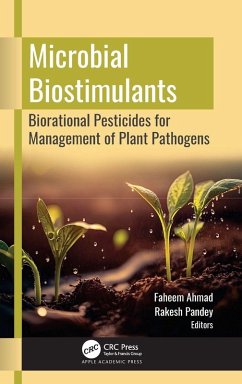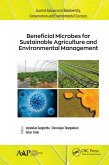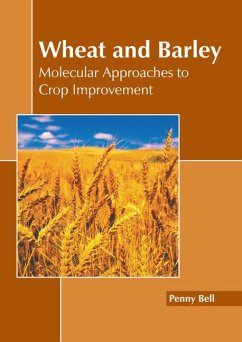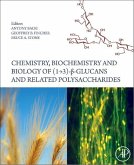Microbial Biostimulants
Biorational Pesticides for Management of Plant Pathogens
Herausgeber: Ahmad, Faheem; Pandey, Rakesh
Microbial Biostimulants
Biorational Pesticides for Management of Plant Pathogens
Herausgeber: Ahmad, Faheem; Pandey, Rakesh
- Gebundenes Buch
- Merkliste
- Auf die Merkliste
- Bewerten Bewerten
- Teilen
- Produkt teilen
- Produkterinnerung
- Produkterinnerung
Details how microbial-based biopesticides can be used for managing pests and plant diseases as well as for the promotion of growth. Explores the advantages of employing microbial biostimulants and their application as a response to the need for increased productivity and plant health.
Andere Kunden interessierten sich auch für
![Plant Abiotic Stress Physiology Plant Abiotic Stress Physiology]() Plant Abiotic Stress Physiology178,99 €
Plant Abiotic Stress Physiology178,99 €![Plant Abiotic Stress Physiology Plant Abiotic Stress Physiology]() Plant Abiotic Stress Physiology178,99 €
Plant Abiotic Stress Physiology178,99 €![Beneficial Microbes for Sustainable Agriculture and Environmental Management Beneficial Microbes for Sustainable Agriculture and Environmental Management]() Beneficial Microbes for Sustainable Agriculture and Environmental Management186,99 €
Beneficial Microbes for Sustainable Agriculture and Environmental Management186,99 €![Wheat and Barley: Molecular Approaches to Crop Improvement Wheat and Barley: Molecular Approaches to Crop Improvement]() Wheat and Barley: Molecular Approaches to Crop Improvement153,99 €
Wheat and Barley: Molecular Approaches to Crop Improvement153,99 €![Maize Genetics and Breeding in the 20th Century Maize Genetics and Breeding in the 20th Century]() Maize Genetics and Breeding in the 20th Century148,99 €
Maize Genetics and Breeding in the 20th Century148,99 €![Chemistry, Biochemistry, and Biology of 1-3 Beta Glucans and Related Polysaccharides Chemistry, Biochemistry, and Biology of 1-3 Beta Glucans and Related Polysaccharides]() Chemistry, Biochemistry, and Biology of 1-3 Beta Glucans and Related Polysaccharides143,99 €
Chemistry, Biochemistry, and Biology of 1-3 Beta Glucans and Related Polysaccharides143,99 €![Charting New Pathways to C4 Rice Charting New Pathways to C4 Rice]() Charting New Pathways to C4 Rice157,99 €
Charting New Pathways to C4 Rice157,99 €-
-
-
Details how microbial-based biopesticides can be used for managing pests and plant diseases as well as for the promotion of growth. Explores the advantages of employing microbial biostimulants and their application as a response to the need for increased productivity and plant health.
Hinweis: Dieser Artikel kann nur an eine deutsche Lieferadresse ausgeliefert werden.
Hinweis: Dieser Artikel kann nur an eine deutsche Lieferadresse ausgeliefert werden.
Produktdetails
- Produktdetails
- Verlag: Apple Academic Press
- Seitenzahl: 430
- Erscheinungstermin: 3. Oktober 2024
- Englisch
- Abmessung: 234mm x 156mm x 25mm
- Gewicht: 798g
- ISBN-13: 9781774916247
- ISBN-10: 177491624X
- Artikelnr.: 70942053
- Herstellerkennzeichnung
- Libri GmbH
- Europaallee 1
- 36244 Bad Hersfeld
- gpsr@libri.de
- Verlag: Apple Academic Press
- Seitenzahl: 430
- Erscheinungstermin: 3. Oktober 2024
- Englisch
- Abmessung: 234mm x 156mm x 25mm
- Gewicht: 798g
- ISBN-13: 9781774916247
- ISBN-10: 177491624X
- Artikelnr.: 70942053
- Herstellerkennzeichnung
- Libri GmbH
- Europaallee 1
- 36244 Bad Hersfeld
- gpsr@libri.de
Faheem Ahmad, PhD, is a Senior Assistant Professor in the Department of Botany at Aligarh Muslim University, Aligarh, India. His research is based on the study of plant-nematode interaction, plant disease, microbe-mediated biotic stress management, and agricultural biotechnology and microbiology. He is the author of more than 43 papers, associate editor of the Journal of Plant Diseases and Protection (Springer), and academic editor of Peer J-Life & Environment.Dr. Ahmad has guided one PhD student and several MSc students to date. He is a recipient of several fellowships and awards, including NRF, TSRO Young Scientist, SERB-DST Young Scientist, and TUBITAK Foreign Researcher Award. He is a fellow of the International Society for Development and Sustainability (Japan) and Bose Science Society (India). He gained postdoctoral experiences at Ehime University (Japan), North-West University (South Africa), Ege University (Turkey), and National Sun Yat-Sen University (Taiwan). Rakesh Pandey, PhD, is Professor Emeritus (Academy of Scientific & Innovative Research) and Emeritus Scientist, Crop Protection and Production Division, CSIR-Central Institute of Medicinal and Aromatic Plants, Lucknow, India. He has authored many research papers, book chapters, review articles, books, and bulletins. He holds four US patents and has developed eight disease-resistant plant varieties of medicinal and aromatic plants. He has 29 rhizospheric microbes accession numbers from the National Center for Biotechnology Information. He is a Fellow of the National Academy of Agricultural Sciences (NAAS), New Delhi. He is a recipient of several national and international awards including the Prof. H.M. Shah Memorial Award (2017), Dr. Manmohan Attavar Gold Medal in Floriculture (2017), M.R. Siddiqi Memorial Award (2018), and Prof. Uma Kant Sinha Memorial Award (2021), among others. He is President of the Indian Phytopathological Society (2022-23). Dr. Pandey has so far guided 13 PhD students and several MSc and MTech students. He has been granted several projects from national funding agencies. Dr. Pandey is an expert and task force member of the Department of Science and Technology (DST), Department of Biotechnology (DBT), Council of Scientific & Industrial Research (CSIR), and Indian Council of Agricultural Research (ICAR) for crop protection-related projects and selections.
1. Pests and Diseases: A Global Threat to Plants 2. Production of Microbial
Biostimulants as a Response to the Modern Agricultural Need for
Productivity and Plant Health 3. Bacillus Species: Prospects and
Applications for Root-Knot Disease Management 4. Arbuscular Mycorrhizal
Fungi to Protect Vegetable Crops from Pathogenic Root-Knot Nematodes 5.
Unravelling the Mechanism of Microbial Biostimulants for Controlling Pests
and Diseases 6. Rhizobacteria as a Potential Bioagent against Root-Galling
Disease in Vegetable Crops 7. The Role of Endophytic Bacteria in Plant
Immune Responses and Plant Disease Control 8. Exploring the Role of
Piriformospora indica and Pichia anomala in the Management of Plant
Pathogens 9. Fungal Endophytes in Plants: Friends or Betrayers? 10.
Promoting Plant Growth by ACC Deaminase Enzyme-Producing Bacterial
Endophytes Under Biotic Stress Conditions 11. Rhizobacteria-Induced
Resistance in Plants towards Cyst Nematodes 12. Microbial and Algal
Biostimulants: Modern Approach towards the Next Generation of Sustainable
Agriculture 13. Microbiota in the Edible Mushroom Industry: Disease
Management, Yield, and Quality Improvement 14. Microbial Consortia as Plant
Biostimulants: Definition, Concept, Categories, and Regulation 15.
Conditioning Root-Associated Microbiota through Root-Exudate Metabolites to
Protect Plants against Soil-Borne Diseases 16. Potential of
Entomopathogenic Fungi in Plant Health Management
Biostimulants as a Response to the Modern Agricultural Need for
Productivity and Plant Health 3. Bacillus Species: Prospects and
Applications for Root-Knot Disease Management 4. Arbuscular Mycorrhizal
Fungi to Protect Vegetable Crops from Pathogenic Root-Knot Nematodes 5.
Unravelling the Mechanism of Microbial Biostimulants for Controlling Pests
and Diseases 6. Rhizobacteria as a Potential Bioagent against Root-Galling
Disease in Vegetable Crops 7. The Role of Endophytic Bacteria in Plant
Immune Responses and Plant Disease Control 8. Exploring the Role of
Piriformospora indica and Pichia anomala in the Management of Plant
Pathogens 9. Fungal Endophytes in Plants: Friends or Betrayers? 10.
Promoting Plant Growth by ACC Deaminase Enzyme-Producing Bacterial
Endophytes Under Biotic Stress Conditions 11. Rhizobacteria-Induced
Resistance in Plants towards Cyst Nematodes 12. Microbial and Algal
Biostimulants: Modern Approach towards the Next Generation of Sustainable
Agriculture 13. Microbiota in the Edible Mushroom Industry: Disease
Management, Yield, and Quality Improvement 14. Microbial Consortia as Plant
Biostimulants: Definition, Concept, Categories, and Regulation 15.
Conditioning Root-Associated Microbiota through Root-Exudate Metabolites to
Protect Plants against Soil-Borne Diseases 16. Potential of
Entomopathogenic Fungi in Plant Health Management
1. Pests and Diseases: A Global Threat to Plants 2. Production of Microbial
Biostimulants as a Response to the Modern Agricultural Need for
Productivity and Plant Health 3. Bacillus Species: Prospects and
Applications for Root-Knot Disease Management 4. Arbuscular Mycorrhizal
Fungi to Protect Vegetable Crops from Pathogenic Root-Knot Nematodes 5.
Unravelling the Mechanism of Microbial Biostimulants for Controlling Pests
and Diseases 6. Rhizobacteria as a Potential Bioagent against Root-Galling
Disease in Vegetable Crops 7. The Role of Endophytic Bacteria in Plant
Immune Responses and Plant Disease Control 8. Exploring the Role of
Piriformospora indica and Pichia anomala in the Management of Plant
Pathogens 9. Fungal Endophytes in Plants: Friends or Betrayers? 10.
Promoting Plant Growth by ACC Deaminase Enzyme-Producing Bacterial
Endophytes Under Biotic Stress Conditions 11. Rhizobacteria-Induced
Resistance in Plants towards Cyst Nematodes 12. Microbial and Algal
Biostimulants: Modern Approach towards the Next Generation of Sustainable
Agriculture 13. Microbiota in the Edible Mushroom Industry: Disease
Management, Yield, and Quality Improvement 14. Microbial Consortia as Plant
Biostimulants: Definition, Concept, Categories, and Regulation 15.
Conditioning Root-Associated Microbiota through Root-Exudate Metabolites to
Protect Plants against Soil-Borne Diseases 16. Potential of
Entomopathogenic Fungi in Plant Health Management
Biostimulants as a Response to the Modern Agricultural Need for
Productivity and Plant Health 3. Bacillus Species: Prospects and
Applications for Root-Knot Disease Management 4. Arbuscular Mycorrhizal
Fungi to Protect Vegetable Crops from Pathogenic Root-Knot Nematodes 5.
Unravelling the Mechanism of Microbial Biostimulants for Controlling Pests
and Diseases 6. Rhizobacteria as a Potential Bioagent against Root-Galling
Disease in Vegetable Crops 7. The Role of Endophytic Bacteria in Plant
Immune Responses and Plant Disease Control 8. Exploring the Role of
Piriformospora indica and Pichia anomala in the Management of Plant
Pathogens 9. Fungal Endophytes in Plants: Friends or Betrayers? 10.
Promoting Plant Growth by ACC Deaminase Enzyme-Producing Bacterial
Endophytes Under Biotic Stress Conditions 11. Rhizobacteria-Induced
Resistance in Plants towards Cyst Nematodes 12. Microbial and Algal
Biostimulants: Modern Approach towards the Next Generation of Sustainable
Agriculture 13. Microbiota in the Edible Mushroom Industry: Disease
Management, Yield, and Quality Improvement 14. Microbial Consortia as Plant
Biostimulants: Definition, Concept, Categories, and Regulation 15.
Conditioning Root-Associated Microbiota through Root-Exudate Metabolites to
Protect Plants against Soil-Borne Diseases 16. Potential of
Entomopathogenic Fungi in Plant Health Management








